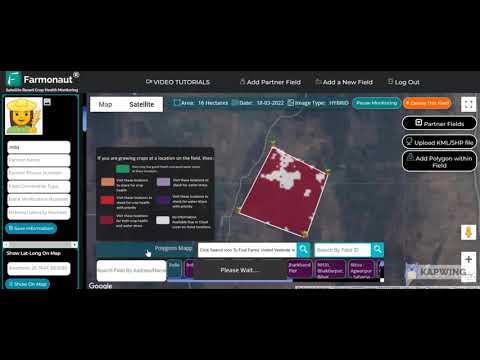Ontario’s Agricultural Risk Management: Federal Co-Funding Debate and Its Impact on Canadian Farm Policy
“The Growing Forward program is a key component of Canada’s agricultural policy, impacting thousands of farmers across the country.”

In the ever-evolving landscape of Canadian agriculture, we find ourselves at a critical juncture. The intricate dance between federal and provincial governments in supporting our nation’s farmers has reached a pivotal moment. As we delve into the complexities of agricultural risk management programs and their impact on Canadian farm policy, it’s crucial to understand the stakes involved for our agricultural sector, our economy, and our place in the global market.
At Farmonaut, we recognize the importance of staying informed about these policy debates and their potential impacts on farming operations. Our mission to make precision agriculture accessible aligns with the broader goal of supporting Canadian farmers through innovative technologies and data-driven insights. As we explore the intricacies of federal and provincial agricultural support initiatives, we’ll also touch on how satellite-based solutions can complement government programs in managing farm risks.
The Growing Forward Program: A Cornerstone of Canadian Agricultural Policy
The Growing Forward program has been a fundamental pillar of Canadian farm policy for years. This federal-provincial-territorial initiative aims to drive innovation, competitiveness, and market development in the agricultural sector. However, recent debates on Parliament Hill have brought the program’s future and structure into question.
- Federal-provincial cost-sharing model
- Focus on research, innovation, and market expansion
- Support for risk management and disaster mitigation
As discussions unfold, the potential reshaping of the Growing Forward program could have far-reaching implications for farmers across Canada, particularly in provinces like Ontario and Quebec.
Provincial Initiatives: Ontario and Quebec at the Forefront
Ontario and Quebec, being agricultural powerhouses, have been proactive in developing their own risk management strategies. These provincially designed programs aim to address the unique challenges faced by farmers in these regions. However, the implementation and sustainability of these initiatives hinge significantly on federal co-funding.
- Ontario’s Risk Management Program (RMP)
- Quebec’s Farm Income Stabilization Insurance (ASRA)
- Challenges in securing federal support
The debate over federal co-funding for these provincial programs has intensified, reflecting the complex interplay between different levels of government in shaping agricultural policy.
The AgriFlexibility Program: Bridging Federal and Provincial Interests
The AgriFlexibility program represents an attempt to create a more adaptable framework for agricultural support. This initiative aims to provide provinces with greater latitude in addressing their specific agricultural needs while maintaining a degree of federal oversight and support.
- Flexible funding allocation
- Support for regional agricultural priorities
- Potential for innovative risk management approaches
As debates continue, the role of AgriFlexibility in balancing federal and provincial interests remains a key point of discussion in Canadian agricultural policy negotiations.
Impact on Export Markets and Trade Relations
The structure and implementation of agricultural risk management programs in Canada have significant implications for our export markets and international trade relations. As a major agricultural exporter, Canada must carefully navigate the fine line between supporting its farmers and adhering to international trade agreements.
- Potential for trade disputes over subsidies
- Impact on competitiveness in global markets
- Balancing domestic support with international obligations
The ongoing debates surrounding farm policy could influence Canada’s position in negotiations over agricultural countervailing duties and market access.

“Ontario and Quebec, representing over 50% of Canada’s agricultural output, face challenges in securing federal co-funding for risk management.”
Financial Safeguarding: A Critical Aspect of Farm Policy
Farm financial safeguarding measures are essential components of agricultural policy. These programs aim to protect farmers from market volatility, natural disasters, and other risks inherent to agriculture. The ongoing debates in Ottawa will shape the future of these safeguards and their effectiveness in supporting Canadian farmers.
- Crop insurance programs
- Income stabilization measures
- Disaster relief funding
As policy discussions evolve, the balance between federal support and provincial autonomy in implementing these safeguards remains a contentious issue.
The Role of Technology in Agricultural Risk Management
As debates over government programs continue, it’s crucial to recognize the role that technology plays in modern agricultural risk management. At Farmonaut, we believe that satellite-based solutions and data-driven insights can complement government initiatives in supporting farmers.
- Real-time crop health monitoring
- Weather forecasting and disaster prediction
- Resource optimization and yield improvement
By leveraging advanced technologies, farmers can better manage risks and enhance their resilience, regardless of the outcome of policy debates.
Explore Farmonaut’s satellite-based farm management solutions:
The Path Forward: Balancing Federal and Provincial Interests
As we look to the future of Canadian agricultural policy, finding a balance between federal oversight and provincial autonomy remains crucial. The ongoing debates in Parliament and across provincial legislatures will shape the landscape of agricultural support for years to come.
- Potential for new hybrid funding models
- Increased focus on regional agricultural needs
- Integration of technological solutions in policy frameworks
The resolution of these debates will have far-reaching implications for farmers, agribusinesses, and the broader Canadian economy.
Comparative Analysis of Canadian Agricultural Risk Management Programs
| Program Name | Level of Government | Primary Objectives | Funding Structure | Key Beneficiaries | Estimated Annual Budget (CAD millions) | Current Status | Potential Impact on Trade Relations |
|---|---|---|---|---|---|---|---|
| Growing Forward | Joint Federal-Provincial | Innovation, competitiveness, market development | 60% Federal, 40% Provincial | All agricultural sectors | 1,500 | Under Debate | Medium |
| AgriFlexibility | Federal | Regional adaptability, risk management | 100% Federal | Varies by province | 500 | Active | Low |
| Ontario Risk Management Program | Provincial | Income stabilization | 100% Provincial (seeking federal co-funding) | Ontario farmers | 100 | Active | Low |
| Quebec ASRA | Provincial | Farm income stabilization | 100% Provincial (seeking federal co-funding) | Quebec farmers | 300 | Active | Medium |
The Role of Data in Shaping Agricultural Policy
In the era of big data and precision agriculture, the role of accurate, real-time information in shaping agricultural policy cannot be overstated. At Farmonaut, we understand the importance of data-driven decision-making in both farm management and policy formulation.
- Satellite-based crop monitoring for policy evaluation
- AI-driven yield prediction for resource allocation
- Blockchain-based traceability for trade compliance
By leveraging these technologies, policymakers can create more targeted and effective support programs for Canadian farmers.
Explore Farmonaut’s API for agricultural data integration:
Farmonaut Satellite API
API Developer Documentation
The Impact on Canadian Farmers and Agribusinesses
As the debates over agricultural risk management programs continue, it’s crucial to consider the direct impact on Canadian farmers and agribusinesses. The outcomes of these policy discussions will shape the operational landscape for agricultural producers across the country.
- Changes in financial support structures
- Potential shifts in crop choices and production methods
- Implications for farm investments and long-term planning
Farmers and agribusinesses must stay informed and adaptable as the policy landscape evolves.
International Perspectives: Lessons from Global Agricultural Policies
As Canada grapples with its agricultural policy challenges, there are valuable lessons to be learned from international approaches to farm financial safeguarding and risk management.
- European Union’s Common Agricultural Policy
- United States’ Farm Bill programs
- Innovative approaches in emerging agricultural nations
By examining global best practices, Canadian policymakers can refine and improve our domestic agricultural support systems.
The Future of Canadian Agricultural Policy
As we look towards the future, the path of Canadian agricultural policy remains uncertain but full of potential. The ongoing debates and negotiations will shape a new era of support for our nation’s farmers and agricultural sector.
- Potential for more flexible, regionally-tailored programs
- Increased integration of technology in policy implementation
- Greater focus on sustainability and climate resilience
Whatever the outcome, the future of Canadian agriculture will depend on the collaborative efforts of federal and provincial governments, industry stakeholders, and innovative companies like Farmonaut.
Conclusion: Navigating the Changing Landscape of Canadian Farm Policy
As we’ve explored throughout this analysis, the debate over federal co-funding and the structure of agricultural risk management programs is reshaping the landscape of Canadian farm policy. The outcomes of these discussions will have far-reaching implications for farmers, agribusinesses, and the broader Canadian economy.
At Farmonaut, we remain committed to supporting Canadian farmers through these changes by providing cutting-edge satellite-based farm management solutions. As policy evolves, the role of technology in mitigating agricultural risks and enhancing productivity becomes even more crucial.
We encourage all stakeholders in Canadian agriculture to stay informed about these policy developments and to consider how technological solutions can complement government programs in managing farm risks. Together, we can work towards a more resilient, productive, and sustainable agricultural sector for Canada.
FAQ Section
Q: How will the changes in agricultural risk management programs affect small-scale farmers?
A: Small-scale farmers may see shifts in available support mechanisms. It’s crucial to stay informed about program changes and explore technological solutions like Farmonaut to enhance farm management practices.
Q: What role does technology play in modern agricultural risk management?
A: Technology, such as satellite-based monitoring and AI-driven insights, plays a crucial role in helping farmers manage risks more effectively. These tools can complement government programs by providing real-time data for informed decision-making.
Q: How might changes in Canadian agricultural policy impact international trade relations?
A: Changes in support programs could affect Canada’s position in trade negotiations and potentially impact export markets. It’s important to balance domestic support with international trade obligations.
Q: What are the key differences between federal and provincial agricultural support programs?
A: Federal programs often focus on nationwide initiatives and broad risk management, while provincial programs tend to address region-specific needs and challenges. The current debate centers on finding the right balance between these approaches.
Q: How can farmers prepare for potential changes in agricultural policy?
A: Farmers should stay informed about policy discussions, engage with local agricultural organizations, and explore technological solutions like Farmonaut to enhance their risk management strategies.






